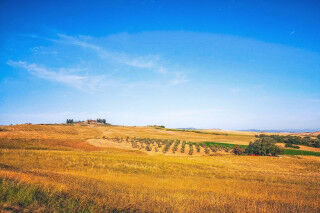WHAT SPARKED THE LATEST CULINARY OUTRAGE
The latest food debate roiling the Italian culinary world was caused by none other than the North American NYT Cooking, the very popular cooking section of the prestigious New York Times newspaper. What’s all the noise about? NYT Cooking proposed a vegan “bolognese" sauce. Taking the place of traditional meat, the food developers and editors of the paper included mushrooms and walnuts, and even a handful of Marmite.
“What’s that?” you might say. This yeast-based spread gained a great following in the UK market, although it’s not nearly as popular outside Anglo-speaking communities. Most in Italy have never heard of this creation that was added to the vegan Bolognese sauce to add umami. Traditional Emilia-Romagna beef-based ragout harnesses its umami from long, slow cooked beef or other red meats present in classic Bolognese sauce.
The Comments section of the NYT Cooking article, have taken the brunt of the Italian public’s responses. Reactions range from the flummoxed to the farcical, with all variations of human emotion in between. Some commentators have joked about this new variation, although there have been plenty of angry respondents, some even offering treatises on the lack of respect for “authentic” Italian cuisine.
Taking it just a step further, some even suggested the notion of “cultural colonialism,” suggesting that the appropriation of Italian culinary heritage is an offensive act, even a latent expression of a racist mentality, etc.
ITALIANS MAD AT FOOD
Italian reacting to “modified” traditional Italian recipes is quickly becoming a web sensation of its own. The NYT Cooking has opened itself up to international criticism with these adjusted takes on classic Italian dishes, particularly considering the Vegan Ragout and a Carbonara Pasta dish with tomato. However, they come prepared, and have even anticipated the inevitable reactions, urging home cooks to give their creations a chance before leaping into an active criticism fray.
But the reply of the NYT Cooking team came as too little, too late. Italian readers were not to be appeased, and their goal of inspiring new approaches did little to appease the group of “Italians Mad at Food,” a Facebook community created and populated by commentators’ reactions to creative interpretations of traditional Italian recipes.
When the official Facebook page for the UK branches of supermarket chain Aldi recommended “leaving your pasta to soak overnight to cut back on cooking time,” one user simply replied with a curt, lapidary “but why?”
HISTORY WITH A LOWERCASE “s”
The history of food is, without a doubt, a history of transformation and evolution. It’s easy to forget how recent a history we’re talking about: many of the iconic recipes of Italian tradition are no older than 100 years in their form we recognize and enjoy today, sometimes much less than that. Lest we forget, the tomato, such an iconic and fundamental part of Italian cuisine, was first introduced to Italy in the mid 16th century, sailing over from the Americas.
At this time, the notion of Italy as a nation was already in the works, but the base of a classic Italian dish, traditional Neapolitan-style pizza as we know and enjoy it today, has been crafted with direct leavening, and incorporating “strong” or high-protein content flours. The catch? This sort of flour has only been in Italy since the Marshall Plan was enacted at the conclusion of WWII, so just over 70 years ago. We won’t even get into the arena with Italian coffee.
And what about another Italian icon, Carbonara pasta? Legend dictates that this iconic Roman dish was born from the desire of American GIs to combine their breakfast rations with Italian pasta. And even if we can prove these as the dish’s noble roots, its history at that point would be on the same timeline of the Neapolitan-style pizza above.
FOOD AS CULTURE
This concept is perhaps less trivial than it seems at first glance. If nothing else, we can all agree on paper that respect for other cultures is a fundamental concept. So, in following this train of thought we can easily surmise that a nation’s culinary tradition is an essential part of national identity and material culture.
What can we say about this identity mangling and cultural appropriation? What is cultural appropriation if not “borrowing” elements of other cultures and making them into our own cultural signals without maintaining their original context? Cultural appropriation boils down to the transformation of certain elements originating elsewhere (a hairstyle, a dish in our case, or an accessory of fashion, to cite a few examples) and keeping only that element’s surface meaning, ultimately disrespecting its original content.
With this awareness of the concept of cultural appropriation then, is it right for the Italian community to demand recognition of our culinary identity, or are we getting into a tizzy over nothing (like the by-now inedible soaked pasta)?
Contemporary culture does provide numerous examples of culinary cultural appropriation. This has been amply showcased in recent history when Asian-Americans called upon the American population to “love our people like you love our food,” in response to a wave of hate crimes against the Asian American community over the past year.
In this case, the stark realizaton that many entrepreneurs and restauranteurs who have found great success in promoting Asian restaurants are often white. To further their profit and gains, many are pushing ahead with an approach to “clean eating” geared towards the Western palate, whilst ignoring the origins of the many individual origins of Asian cuisines.
ITALIAN CUISINE RECOGNIZED THROUGHOUT THE WORLD
Discourse swirling around Italian cuisine is radically different from this approach. Italian cuisine is by today’s standards, a completely global, universal movement. Italian cooking is a melody humming along in the ears of all nations, and provides each of us with a multi-hued palate of flavors and ingredients.
Industry fraud, like Parmigiano Reggiano or Amarone chicanery are always to be condemned, no ifs and or buts about it. As for the other permutations of Italian cooking, well, Italian cooking is based in making do with little, of shortcuts, and with the notion of making do. Italian cooking has shoulders that are more than wide enough to bear the weight of reinventions, modifications, and “tweaks” of its iconic, fabulous original recipes.
Since we’re focusing on the “classics,” come check out the Recipe Index for lots of cooking inspiration and ideas of creating your very own delicious Tuscan dishes. What’s one very traditional Italian ingredient? Piave Cheese, produced singularly in one northern Italian region - come check out the story behind this delicious selection. And while you’re here, read all about the Piave DOP Consortium’s efforts at getting this cheese out to other dairy fanatics across the globe.
That should get you started, but be sure to sign up below for delicious Italian recipes, wine news, and tips in the Mamablip newsletter. A quick sign-up and you'll get these details delivered right to your inbox once a week - could living like an Italiano be any easier?












